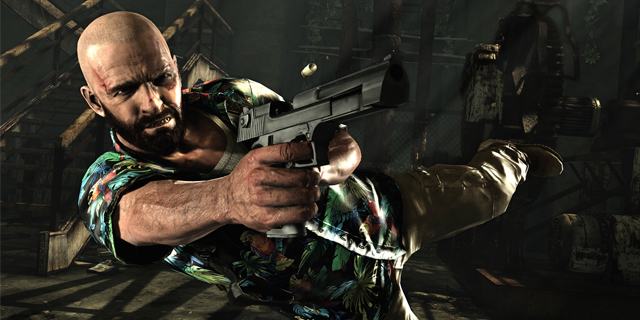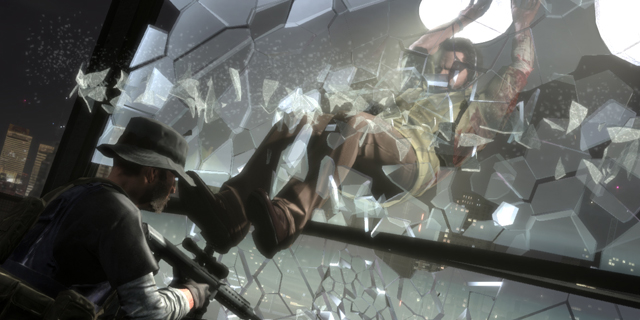
Right before Max Payne 3 released, I was unsure of what to expect. I knew that Remedy, the developer of the first two games, had a distinct style, and I was curious to see how Rockstar would approach that. Thankfully, instead of attempting to recreate the style that made the series well-known, Rockstar went down their own path. What we have is a game that, in many respects, pays homage to the original two titles while becoming an entirely different, Rockstar-styled action game of its own.
Taking place several years after the events of Max Payne 2, we follow the titular hero, who has since retired from the NYPD, in Brazil, where he has taken a private security job to protect a wealthy family. It isn’t long before things take a turn for the worse, and Max is left to clean up the mess that is left behind. Max’s narration carries us through the entire journey, as he curses both the job and his life, popping pills and drinking plenty of liquor along the way. This is a typical, albeit entertaining, crime story that is interwoven with Max’s struggles as he fights both his enemies and his personal demons.
In true Max Payne fashion, the story is relentless, as is Max’s narration, never giving us a moment to ponder exactly what he’s thinking during specific story beats. The story itself is excellent, and Rockstar, ditching the traditional comic-book style of the previous games, gives us a grittier tale this time around. There are plenty of homages to the previous two games, some only long-time fans will understand, but this is a brand new story that feels like a fresh start for both Max Payne’s life and the franchise as a whole. It’s well-written and engaging from start to finish, leaving you with the desire to see Max’s journey continue after the credits roll.
Rockstar attempts something a bit different with the franchise, with actual cutscenes replacing the comic panels from the previous games, and every scene laced with interesting, jumpy effects that rely on multiple frames and key pieces of dialogue appearing on screen. It’s something that you need to see to understand, but it works, reminding me of a toned down version of Kane and Lynch 2’s handheld camera presentation. It tends to be a little much at times, but overall it’s used to great effect. No matter how you look at it, it’s a gorgeous game with plenty of style. Top that off with a brand new score that combines previous songs from the series with brand new tracks, adding an exciting new flavor to Max Payne’s dreary, orchestral score.
For better or worse, the gameplay in Max Payne 3 has remained mostly unchanged. It’s still a third person shooter with a heavy emphasis on slowing down time to mow down enemies, action-movie style. You can trigger the bullet time whenever you want, or, as usual, when diving through the air to look even cooler while taking down enemies. The controls are tuned just right and the aiming, which can allow for lock on targeting or free aim, is always precise. The gunplay as a whole is still as fun as it’s always been and is a nice change from the average shooters on the market.
It’s been a while since the last Max Payne game, so the addition of a cover system is a no-brainer. This feature creates a more methodical pace for the firefights, allowing you to rely less on the bullet time. You still find plenty of reasons to use it throughout the game’s many shootouts, but something feels a little lost in the transition from the previous titles. While there are a lot of scripted sequences that are entirely focused on bullet time, you can go through most of the game without having to use it, which is a little strange. They couldn’t remove it, but the addition of cover makes its necessity feel lessened as a result. Regardless, the cover system is a nice addition that adds a little more strategy to each fight, and combined with the bullet time, there are still plenty of enjoyable moments to be had.

To balance out the addition of the cover system, Max is even more fragile than he was before. If you find yourself exposed in a room full of enemies, it won’t be long before you hit the ground. Max is once again relying on bottles of painkillers to survive as Rockstar has decided to go old school instead of relying on the now-popular regenerating health mechanic. Luckily, if Max is taken down and has painkillers on hand, he has a chance to survive by killing the enemy that last shot him. This gives players unfamiliar with the previous games a chance to get back on their feet (until they run out of health items) and is a fine addition to the core gameplay.
New to the series is multiplayer, which brings a few of Max’s signature moves to the typical competitive third person shooter experience. You earn abilities during matches that you can use, such as bullet time (which slows down time for everyone in the immediate area), and are used to mix things up. Most of the gameplay feels standard, and despite their best efforts, the experience feels out of place in a Max Payne game. The mechanics work surprisingly well in a multiplayer setting, but in a market full of competitive shooters, this is one that won’t hold your attention for more than a week.
Those expecting a return to the Max Payne series that Remedy made famous might be disappointed, but Rockstar has done a lot to preserve as much of what made the franchise great while making it their own. The gameplay is still as solid as ever and it shows that, despite some disconnect with gameplay mechanics, there is still room for this series to grow. Hopefully this isn’t the last time we see Max Payne.
Pros: Brilliantly written story, fantastic visuals and music, gunplay is as satisfying as ever
Cons: Some disconnect between the old mechanics and the new, multiplayer feels tacked on



















